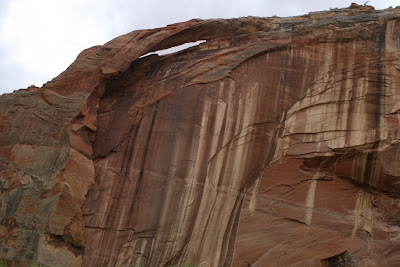 For an audience of just two, the Author of this critically acclaimed masterpiece spared no expense, every detail proving the transcendency of His production values. From the entrance to the theatre, to the pre- and post-show entertainment, each human sense was pleasantly invited to participate until the storied climax lifted our spirits to their feet in thunderous applause. It was choreography of universal magnitude that played just once--and that once, offered exlusively for us.
For an audience of just two, the Author of this critically acclaimed masterpiece spared no expense, every detail proving the transcendency of His production values. From the entrance to the theatre, to the pre- and post-show entertainment, each human sense was pleasantly invited to participate until the storied climax lifted our spirits to their feet in thunderous applause. It was choreography of universal magnitude that played just once--and that once, offered exlusively for us.
We entered the canyon by mule and mustang after a day of hard rain, with the promise of more to come. Broken clouds filtered the sunlight on the sandstone cliffs and the sweet smell of Russian Olive wafted through the canyon against the fresh smell of wet-desert. Dense foliage along the silt-laden river made passage difficult for mule and rider. We were in the foyer of the grand amphitheater and the decor consisted of an arch, a natural bridge, panels of ancient art, and a cliff house safely ensconced above our reach.
Crossing the river a couple more times, we found ourselves inside the main hall. Just in time for the grand entrance, we took our seating, box-style in an alcove under an overhang in the red rock. Camp had been struck, the mules cared for, and dinner prepared at our feet. As if on cue, the house lights dimmed as dark clouds gathered. In the pit, the orchestra rewarded our anticipation with a clap of thunder that reverberated up and down the canyon walls. It was Act I. The soft sound of the wind rustling through the cottonwood trees was soon replaced by the dissonant, white noise of rain beating against every instrumentality in the theatre. A sudden chill brushed our faces while the smell of ozone and rain mixed with the scent of Russian Olive and tamaracks. For about 20 minutes, we watched the plot unfold.
Act I faded as quickly as it started, and Act II entered above stage. The grand thrones across the canyon began to shed their water, ending the momentary silence. The high-pitched, percussive sound of impromptu water falls lifted our eyes upward while the dancing and splashing of pure, life-giving water followed ancient courses sculpted in the sandstone by rains past. For about 20 minutes, we watched and listened to Act II as it
crescendoed to a fevered pitch, then softly faded back into the base silence of the
Escalante river.
Act III, the grand finale, entered below stage. A flash flood of muddy water came charging down the canyon, boldly altering the topography with its abrasive force. The quiet background music of the
Escalante built into a climactic roar as nature displayed her mighty power. BRAVO! For another hour, the domed river ran high and thick and our ovation lasted long after night's curtains were drawn and the stage emptied.
The post-show glow flickered against the alcove walls as our campfire held the darkness of night outside. Eventually, we retired to our sleeping bags, anxious for the morning so we could explore Sand Creek canyon--dreaming of what surprises lie around the next bend.
We were boyhood pals who grew up in Mona at the foot of Mt Nebo. David Jones and I spent our childhood brushing against the forces of wind, water, season, and storm. Our profession back then was that of
explorer and we hunted, fished and scaled all the wild places on whatever conveyance we could find. Our profession changed to Optometrist as we came of age, and we battled chiggers and ticks while feverishly exploring Missouri where we went to school. Now blessed with businesses and families, it takes monumental effort to do what used to come so naturally.
 |
| Impromptu waterfalls |
David hadn't been on horse since we were kids and he had never been on a mule. He's a smart kid and he quickly learned how to take advantage of Molly's sure footedness. Our journey was a complicated trail that wasn't fit for dudes, but Dave refused to be intimidated. The result was a chance to see the power of the Almighty on display and the time to enjoy the miracle of friendship.

 |
| Molly stuck in quicksand |






 The more I see of Bryce Canyon country, Escalante, the Grand Staircase, and the San Rafael Swell, the more I think I know what drove Butch Cassidy into a life of crime.
The more I see of Bryce Canyon country, Escalante, the Grand Staircase, and the San Rafael Swell, the more I think I know what drove Butch Cassidy into a life of crime. Mount Dutton just North of the Paunsagunt for an overnighter. Preston claims it was his favorite campout, bragging to all who will listen about how he handled that 3 year old mustang all by himself.
Mount Dutton just North of the Paunsagunt for an overnighter. Preston claims it was his favorite campout, bragging to all who will listen about how he handled that 3 year old mustang all by himself.








































